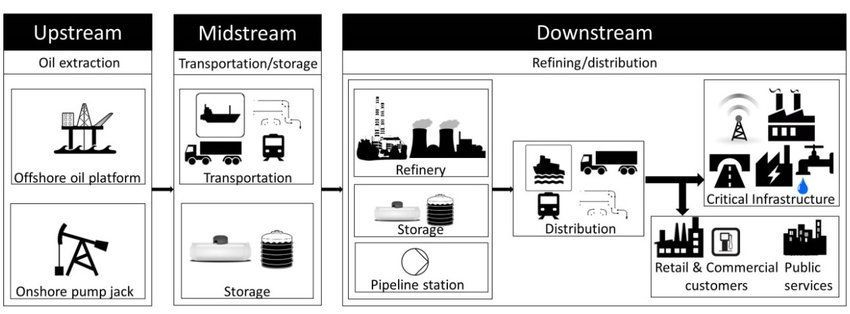Oil and gas consumption has become an important economic indicator. It is a variable that, in a sense, conveys the idea of whether an economy is prospering or, on the contrary, contracting.
However, the conversion of these resources has a significant environmental impact: gas and oil refinery emissions. And this is an issue that we cannot overlook because it sometimes creates problems for nearby communities and workers, as well as for ecosystems and natural resources.
Health cannot become a bargaining chip for economic progress. The goal must be to combine both factors in the pursuit of sustainable growth, where air qualityAir quality refers to the state of the air we breathe and its composition in terms of pollutants present in the atmosphere. It is considered good when poll...
Read more monitoring of emissions from oil refineries and gas fields, is part of everyday life.
What gases do refineries and gas fields emit and where do they originate?
Refineries are the facilities where the transformation of crude oil takes place. The result is products such as diesel and petrol that drive the global economy and asphalt that facilitates road communications.
Air Quality Innovation in Just 1 Click
Stay informed about the air you breathe!
Subscribe to our newsletter to receive the latest updates on environmental monitoring technology, air quality studies, and more.
In the case of gas farms, the main resource is the gas itself, with multiple applications ranging from heat generation to the manufacture of nitrogen fertilisers.
Gas operations and oil refinery pollution occur during the different stages of the distribution chain:
- Upstream, which encompasses the actual drilling and extraction work.
- Midstream, during which transportation via pipeline or other means takes place.
- Downstream, which may include processing, storage, or distribution to the end user.

Source: A Review of Climate Change Impacts to Oil Sector Critical Services and Suggested Recommendations for Industry Uptake CC BY 4.0
Main pollutants
The main air pollutantsAir pollution caused by atmospheric contaminants is one of the most critical and complex environmental problems we face today, both because of its global r...
Read more released are:
- Volatile Organic Compounds (VOCs)
- Particle matter (total particle matter, PM10 and PM2.5)
- Nitrogen oxides (NOx)
- Sulphur dioxide (SO2)Sulphur dioxide (SO2) is a colourless gas with a pungent odour that causes an irritating sensation similar to shortness of breath. Its origin is anthropoge...
Read more - Carbon monoxide (CO)The carbon monoxide (CO) is an invisible gas (colorless and odorless) that, at the same time, is a silent killer because in just a few minutes it exhibits ...
Read more - methane/">Methane (CH4)Methane, known chemically as CH₄, is a gas that is harmful to the atmosphere and to living beings because it has a high heat-trapping capacity. For this ...
Read more
Some of these elements, such as VOCs and NOx, can react with sunlight to produce ozone. Others, such as methane, contribute to global warming, occupying a very important role among greenhouse gasesWhile the concentration of carbon dioxide (CO2) in the atmosphere has been steadily and rapidly increasing in recent decades, in May 2025, CO2 surpassed 43...
Read more. This is why continuous, real-time monitoring of gas fields and oil refinery pollution is critical.
How to reduce the impact of oil refinery emissions and gas fields?
Installations with these characteristics implement and adopt what is known as Best Available Techniques (BAT), reference documents that are applicable when
- an application is made for Integrated Environmental Authorisation (IEA) for new processing units;
- facilities are refurbished and updated, or
- the IEAs are reviewed, which is carried out four years after the publication of the BAT conclusions.
These BATs act on aspects such as the fuel type, opting for those with lower sulphur content, more efficient furnaces and boilers or technologies such as filters or catalysts. And, of course, atmospheric emission monitoring systems.
How do Kunak’s solutions fit into the monitoring of air quality in refineries and gas plants?
Our products can complement pollution monitoring systems for gas fields and oil refineries that are used both for
- continuous measurements that are carried out with permanently installed systems, and
- indirect measurements obtained by an appropriate combination of concentrations in secondary parameters.
Virtual perimeters to control fugitive emissions are a clear example of this.

Our monitoring stations Kunak AIR Pro and Kunak AIR Lite, together with the air quality software Kunak AIR Cloud, make up a complete solution for air quality monitoringControlling air quality is an essential task in order to enjoy optimal environmental conditions for healthy human development and to keep the environment i...
Read more in such installations
This solution involves deploying a network of Kunak AIR monitoring stations around the installation or site. The system, thanks to the smart cartridges system, collect data continuously and in real-time, alerting when it detects unusual levels of pollutants such as CH4, SO2, CO, particulate matter or NOx.
In short, the application of stricter controls and the implementation of the best available techniques along the different stages of the supply chain can help to significantly reduce emissions, minimise environmental impact and maximise efficiency.
And in its implementation, opting for disruptive technologies such as those offered by Kunak is synonymous with a clear commitment to achieving a more sustainable future.

